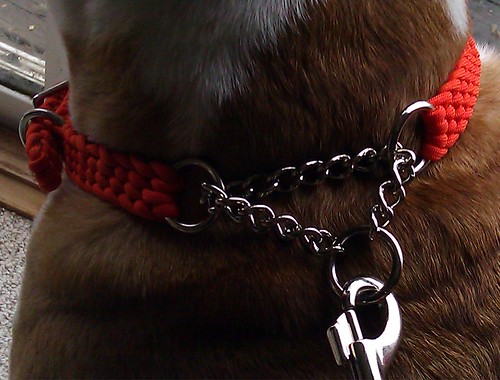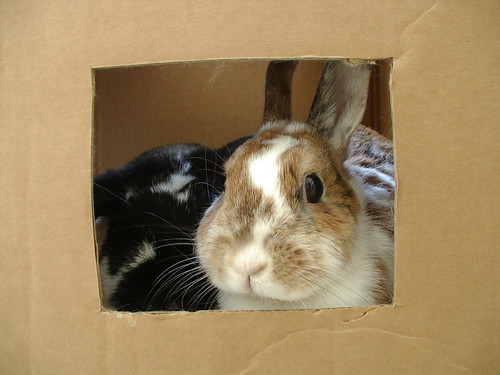Cancer is a fascinating disease. No, really. It is amazing how our genes can betray
us on their own, or due to us abusing them by choice (smoking, sun worshipping, etc.)
or inadvertently (all the other stuff our bodies are exposed to). If you want to read an
excellent book, I recommend
The Emperor of All Maladies, by Siddhartha Mukherjee. It
is a biography of cancer and is really amazing.
 |
lymphoma cells in a RBC background
from a bone marrow biopsy.
Source: Nature.com |
Lymphoma, also called lymphosarcoma,
is a highly malignant tumor of the lymph system. It is the most common form of cancer
in both humans and small animals. Dogs, cats, and young ferrets are hard hit by this
cancer.
What is Cancer?
We do not know how pets and people get cancer most of the time. Cancer starts with
a cell that has mutated due to genes turning on or off, and growth starts to run amok.
These cells are being born in our bodies all the time and we have an assortment of
mechanisms to destroy them before they get out of hand. Sometimes these cancer cells
escape destruction and cancer grows. It begins to divide quickly and without control.
The organ where the abnormal cells live may be destroyed as the cancer cells take
over. Other tissues may become invaded as the tumor cells grow into them. Cancer
cells break away from the primary tumor and travel via blood or lymph vessels to other
areas of the body. Wherever these cells lodge, they can start new tumors. This form of
cancer spread is called metastasis.
What is the Lymph System?
The lymph system is a network of vessels that intersect with the blood stream and
direct foreign material and organisms (bacteria, viruses, etc.) to the lymph nodes that
then process this debris. The lymph nodes are full of the cells of the immune system.
There are many different types of immune-related cells; some produce antibodies, some
circulate and destroy the foreign materials they encounter, some regulate the activity
of other cells. Lymphocytes, a type of white blood cell, are the primary cells of the
lymph system. The spleen and liver are also heavily involved with the lymph system.
Lymphoma can occur anywhere in the body.
What is Lymphoma?
 |
lymphocytes smeared out
from a node aspirate.
Source: BiomedicalCentral.com |
When lymphocytes become cancerous within a lymph node, the node swells and
hardens. Malignant lymphocytes readily travel through the lymph vessels to nearby
lymph nodes. Soon all the nodes are enlarged. Ultimately, the bone marrow where
are blood cells are formed becomes obliterated with these abnormal cells, the immune
system is destroyed, and severe anemia, organ failure, and/or infection usually claim
the victim's life. (Leukemia is another type of white blood cell cancer with circulating
blood cells-these can be immature lymphocytes or other white cell lines. Leukemias are usually detected from a blood sample while lymphomas are detected from taking a
sample from a node or biopsy of other affected tissues. However, lymphoma is also the
most common cancerous cause of hypercalcemia (high blood calcium levels) in dogs,
so that may be detected on bloodwork).
 |
Dog with swollen lymph nodes.
Source: NCSU College of Veterinary Medicine |
The typical dog lymphoma patient is a middle-aged dog who goes to the veterinarian
because one or more lumps have been found. In dogs, the most common lymphoma
form is the multicentric form, where all the lymph nodes of the body seem to enlarge
at once. Certain breeds of dogs are more likely to develop lymphoma, especially the
Golden Retriever, but also the Boxer, Scottish Terrier, Basset Hound, Airedale Terrier,
Chow Chow, German Shepherd, Poodle, St. Bernard, Bulldog, Beagle, Rottweiler.
While multicentric lymphoma can occur in cats, the most common feline form of
lymphoma is currently intestinal. This was not always the case. Years ago, prior to the
widespread use of the feline leukemia vaccine, the mediastinal form (a tumor in the
chest cavity) was the predominant lymphoma form and the leading cause of lymphoma
was the feline leukemia virus. Now the virus has become less common, thanks to more
cats living indoors, effective vaccination, and readily available testing procedures.
The average intestinal lymphoma patient is an elderly cat with a history of vomiting,
diarrhea, weight loss, appetite loss or any combination thereof. A mass may develop
with intestinal lymphoma or the tumor may be more infiltrative. A mass can potentially
cause obstruction in the intestine and lead to a crisis that must be promptly resolved
surgically. Cigarette smoke in the home has been found to double a cat's risk of
developing lymphoma.
WITHOUT TREATMENT, ANIMALS WITH LYMPHOMA ARE EXPECTED TO LIVE
4-8 WEEKS FROM THE TIME OF DIAGNOSIS.
Many patients are not feeling particularly sick at the time of diagnosis. It may be
tempting to hold off on treatment until the pet seems more ill. Waiting can drastically
reduce the chance for long-term survival; better remission quality is obtained if the
patient is treated while still feeling healthy.
What is Remission?
Remission is the state in which symptoms have been abated, the tumor cells are
undetectable for the moment, and the patient doesn’t appear to have cancer. Prolonged
remission is the goal of cancer therapy which, for most lymphoma cases, means
chemotherapy. How long a remission lasts depends on what protocol is used and a
number of other factors. Numerous protocols are available and there is one to fit every
budget and every schedule.
What is Cure?
Cure is the permanent removal of all traces of tumor such that no further treatment
is needed. In effect, it is a permanent state of remission. While this is a possibility for your pet, it is more constructive and realistic to focus on increasing quality time. With
lymphoma, remission is likely but cure is not.
Chemotherapy
Chemotherapy means therapy using medication (as opposed to surgery or radiation,
which can also play a role in lymphoma therapy). The word chemotherapy conjures
images of people losing their hair and suffering chronic overwhelming nausea. It is
unfortunate that many pets (and probably people, too) do not receive chemotherapy
based upon these unpleasant images that poorly represent the current state of
treatment. Decades of research has gone into patient comfort, minimizing side effects,
and maximizing response. There is a lot of research going on to tailor therapy to the
specific genes that are out of control, and several chemotherapeutic agents on the
market for other cancers that target specific gene activity, and which greatly minimizes
side effects.
Only 7% of pet patients require hospitalization due to side effects of chemotherapy.
75% of lymphoma patients go into remission with chemotherapy protocols beyond
prednisone alone. In cats, protocols using multiple drugs yield much better results,
but high grade lymphoma, FeLV+ cats, and cats with lymphoma in the kidneys have a
poorer response to therapy with median survival of 6-9 months. Low grade intestinal
lymphoma cats can live for years while on chemotherapy. The median survival time
for most dogs on chemotherapy (again not just prednisone) is approximately one year
with 25% of dogs surviving two years. T-cell lymphoma is less responsive to medication
than B-cell lymphoma. Luckily, B-cell lymphoma accounts for 75% of canine lymphoma.
Several facilities also are doing bone marrow transplants with their chemotherapy dogs
who have gone into remission and are appropriate candidates. This can be curative in
about 30% of dog patients.
Blog written by:
Dr. Dana Lewis
Posted by Dr. Mary Gardner
Read more or contact Dr. Dana:
 Dana Lewis, DVM
Dana Lewis, DVM
Lap of Love Veterinary Hospice
Raleigh, North Carolina
drdana@lapoflove.com | www.lapoflove.com
Dr. Dana assists families with Pet Hospice and Euthanasia in the Raleigh North Carolina area (Raleigh, Durham, Chapel Hill and the greater Triangle, as well as Wake, Durham, Orange, and Chatham counties.














































